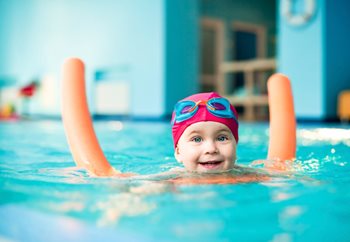Overview
In warm weather, nothing is more refreshing than a swim. It is also a great form of entertainment and exercise for kids. However, there must be appropriate adult supervision.
Common Injuries
Drowning is the second leading cause of accidental death in children ages 5-18. Diving injuries can cause scrapes, cuts, bruises and broken bones. In severe cases, diving can cause spinal cord damage, paralysis and death. Over 1700 spinal cord injuries from diving accidents are reported each year. Paralysis from diving most often results in paralysis in both arms and legs. Sunburn also can happen if your child is not wearing sunscreen.
Age Recommendations
Young or new swimmers should always wear a U.S. Coast Guard approved safety vest when they are around water.
What can you do to make swimming safer?
General
- Wear sun protection particularly between 10 am and 2 pm
- Drink lots of fluids! It is easy to get dehydrated. You may not feel thirsty while you are in the water!
- Do not leave children near the water without an adult watching
- Have young children or inexperienced swimmers wear US Coast Guard approved life vests
- Inexperienced swimmers should limit their depth to where they can “touch”
- Adults should not drink alcohol when supervising swimming children
Pool
- Swim where there is a trained life guard on duty
- Swim with a buddy- do not let anyone swim alone
- Do not dive in shallow water – the safest way to enter the water is feet first
- Secure pools with appropriate barriers
Beach
- Swim in marked areas that have lifeguard supervision
- Obey posted markings that define the swim area
- Do not dive into shallow water or where underwater obstacles are unknown. The safest way to enter the water is always feet first.
- Obey posted warnings about rip tides or strong currents
- If caught in a current, don’t panic! Swim parallel to shore until free of the current
- Do not swim in bad weather, particularly lightning
More Information
Page QR Code:


 POSNA.org
POSNA.org

